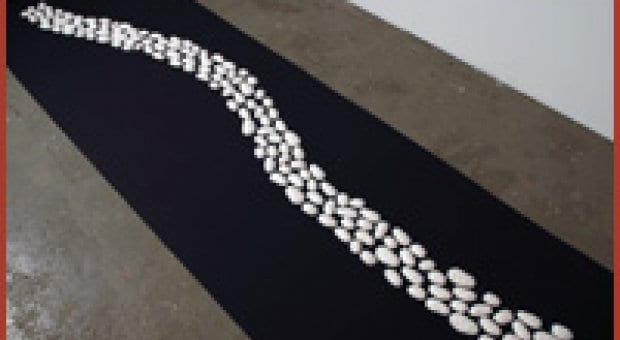“Cosy” sits off to the side of the exhibit, a colossal rainbow extension-cord tea-cozy, large enough for a group of family members to fit underneath, if uncomfortably.
The show, called Relative, which runs until Jan 7 at the Ottawa Art Gallery, is a collaboration of two artists’ sculptures. Ottawa’s Carl Stewart and Montreal’s Monika Napier were brought together by curator Johanna Mizgala.
Mizgala is quick to explain the multi-meaning title of the show.
“The title really has multiple meanings. Monika and I are relatives and we thought-is there a way to turn Carl into a relative? When you’re going to collaborate, ‘family’ really has multiple meanings as well. The word ‘relative’ conjures up so many thoughts,” says Mizgala.
The title is certainly justified. What Stewart and Napier have created are sculptures that highlight aspects of their family life. Although very different, the sculptures are complementary. Stewart has chosen to concentrate on images he remembers from growing up on his father’s potato farm in PEI, using subdued earth tones and the potato as the focal point. Napier’s sculptures, on the other hand, about the instability of her family life while growing up, seem like the pinnacle of modernity – her media are bright, massive extension cords and multi-coloured cable ties.
One of Stewart’s most interesting pieces, “Harvest” incorporates a found object – a wooden trencher – into an autobiographical piece.
“The trencher was used for moving food to the table. I filled it with potatoes, and if you look closely, there is one gold potato in the bunch. I used the gold for aesthetics, but also to show ‘one of these things is not like the other’ so in that way, it is an autobiographical piece,” says Stewart, referencing growing up queer in a small town.
“When you look in [to the trencher], it’s kind of a ceremonial thing. You don’t notice the gold potato until you walk right up and look in, and it kind of asks the question ‘What’s special, what’s significant here?'” adds Mizgala.
Other highlights of the show include Stewart’s “Path,” a 51-foot arc of plaster potatoes meant to symbolize the pathway from the door of his father’s home. Napier’s “Tract,” a re-creation of the digestive system, is made with hunter orange media and is the approximate length of the actual digestive tract.
“This show just works on so many levels,” says Mizgala. “People can enter the work from so many avenues. You can appreciate the work for it’s beauty – you can even laugh at it. But after that, you have to really look at all the different levels of meaning in each piece.”

 Why you can trust Xtra
Why you can trust Xtra


